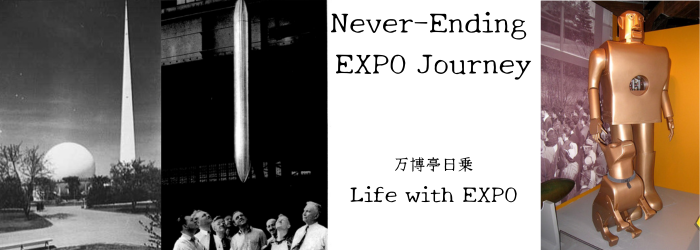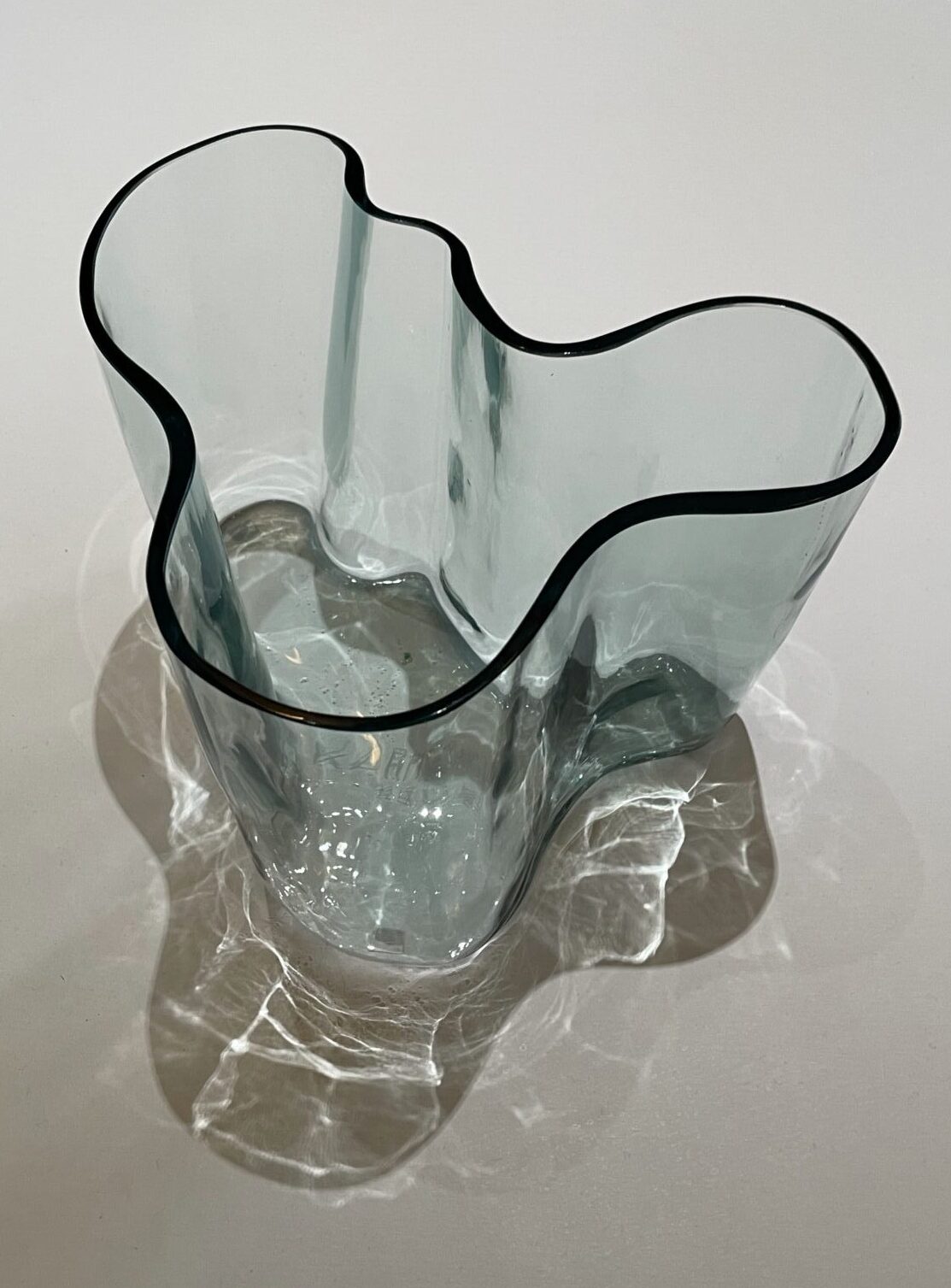Finnish Glass Art – Sparkle and Color in Modern Design
In the previous <28>, I tried to talk about my visit to the exhibition “Finnish Glass Art – Sparkle and Color in Modern Design”, and eventually introduced the “art deco” works of the Tokyo Metropolitan Teien Art Museum (Former Residence of Prince Asaka), which was the venue of the exhibition.
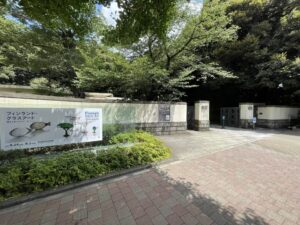
東京都庭園美術館入り口
Entrance, Tokyo Metropolitan Teien Art Museum
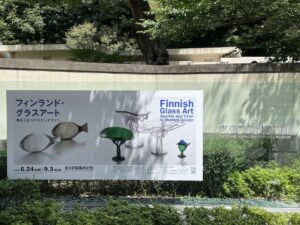
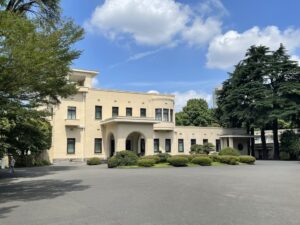
Well, this time, I would like to finally introduce Finnish glass art.
Speaking of Finnish glass art, Iittala is famous.
Last year (2022), from September to November, the “Iittala – Stars of Finnish Glass” was held at Bunkamura in Shibuya, Tokyo.
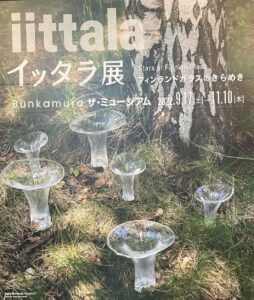
イッタラ展ポスター(文化村)
Poster of “iittala” Exhibition (Bunkamura)
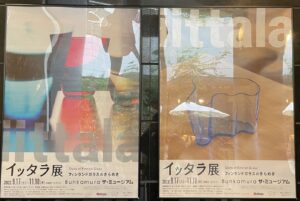
イッタラ展ポスター(文化村)
Poster of “iittala” Exhibition (Bunkamura)
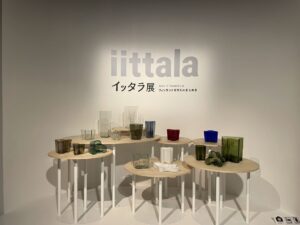
イッタラ展入り口(文化村)
Entrance of “iittala” Exhibition (Bunkamura)
I visited with my assistant No. 0, and was impressed by its sophisticated design.
Also, I learned that Iittala’s designer, Timo Sarpaneva, was in charge of designing the Finnish section of the 1967 Montreal Expo, and I rediscovered that Iittala was also involved in the World Expos.
After being held at Bunkamura in Shibuya, Tokyo, this exhibition was held at the Shimane Prefectural Iwami Art Museum from April to June this year (2023), and then is being held at the Nagasaki Prefectural Museum of Art from July to September.
And this “Finnish Glass Art – Sparkle and Color in Modern Design“.
This time, the works of various Finnish glass art designers are introduced comprehensively.
Moreover, some of the works have been exhibited at international expositions or won prizes there. In addition, many of the works were exhibited at the “Milan Triennale” and won awards.
For Finnish glass art, the fact that it was exhibited at the “Milan Triennale” and was evaluated there seems to have played a major role in its international development.
What is this “Milan Triennale“?
At first glance, it doesn’t seem to have anything to do with the Expo, but in fact, this “Milan Triennale” is an official BIE event authorized by the BIE (Bureau International des Expositions).

BIEのロゴ
The Bureau International des Expositions (BIE) logo.svg
Types of EXPO managed by BIE
As a matter of fact, the following four are currently under the control of the BIE.
World Expo (International Registered Exhibition)
A large-scale international exposition held once every five years. The term is within 6 months. Expo 2005 Aichi, Japan, Expo 2010 Shanghai, Expo 2015 Milan, Expo 2020 Dubai (actually held in 2021 due to the COVID-19 pandemic), and Expo 2025 Osaka, Kansai are included in this category.
Specialised Expo (International Recognized Exhibition)
A special exhibition that can be held only once between two Registered Exhibitions. It deals with a specific theme, and there are regulations that the venue area is 25 hectares or less and the exhibition period is within 3 months.
Horticultural Expo (International Horticultural Exhibition)
BIE can authorize the World Horticultural Exposition (A1 Category Flower Expo) accredited by AIPH (The International Association of Horticultural Producers). Also, the duration of the exhibition is 6 months or less, and there is no upper limit on the size of the venue. Yokohama City is currently promoting the 2027 Flower Expo. Past events include the 1990 Osaka Flower Expo.
Triennale di Milano (The Milan Triennial Exhibition of Decorative Arts and Modern Architecture)
It is recognized by the BIE under the BIE Convention established in 1928, and is sponsored by the Milan Triennale Institute. As the name “Triennale” suggests, it is held once every three years in principle, with a period of less than six months, and historically the venue is the “Palazzo dell’Arte” (Palace of Art) near Duomo in Milan.
The last one “Triennale di Milano” above is commonly known as the “Milan Triennale”.
The first “Milan Triennale” recognized by the BIE was the one in 1933.
However, the 1933 Milan Triennale was not the first Milan Triennale, but actually the fifth.
This event started as a Biennale (held once every two years) in 1923, as an “International Exhibition of Decorative Arts” in Monza, a city located about 15 km northeast of Milan. It was in 1933 that it moved to Milan as the fifth Exhibition.
It was also in 1933 that Finland officially participated for the first time.
The 5th Milan Triennale was held from 10 May to 31 October 1933.
After that, it has been held continuously, in 1936, 1940, 1947, 1951, 1954, and 1957, though not exactly every three years partly due to the effects of the war. The most recent one was held from July 15th to December 11th, 2022.
Structure of the exhibition “Finnish Glass Art – Sparkle and Color in Modern Design”
This exhibition consists of three sections from Section 1 to Section 3.
Section 1 : The Emergence of Finnish Glass Art
A brief history of Finland shows that since 1155 Finland has been under the rule of the Kingdom of Sweden. It was annexed by Russia in 1809 and became independent as Finland in 1917, the year of the Russian Revolution.
According to the catalog of this exhibition, full-scale glass production in Finland began in the mid-18th century. At that time, it was under the rule of the Kingdom of Sweden.
Long-established glass factories such as Iittala (1881-) were established after the annexation of Russia in 1809.
Even after gaining independence from Russia in 1917, the influence of Sweden was strong in Finland, and it was not until the 1930s that Finnishness began to emerge.
Around that time, opportunities to participate in international exhibitions such as the Milan Triennale and the World Expo increased, and Finnish original designs were created.
Alvar Aalto (1898-1976), and his wife, Aino Aalto (1894-1949), and Gunnel Nyman (1909-1948) were representative designers who led the rise of Finnish glass art.
Alva & Aino Aalto
Both Alva and Aino Aalto were architects. They were a talented couple.
Alva won the gold medal at the Milan Triennale in 1933, but it was actually for his furniture design.
The Aaltos also designed the Finnish pavilion for the 1937 Paris World Exposition.
In this exhibition, Alvar Aalto’s “Aalto Vase” (commonly known as “Savoy“), which was exhibited at the 1937 Paris Exposition, is on display. This series are vases that represent Alvar Aalto’s glass works, which was also featured in last year’s Iittala exhibition. This unique organic design is said to have been inspired by lakes in his native Finland.
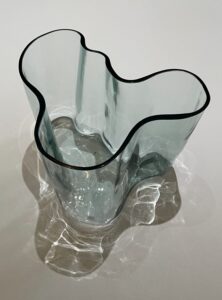
サヴォイ(アルヴァ・アアルト)
Savoy (Alvar Aalto)
Also on display is Alvar & Aino Aalto’s “Aalto Flower”.
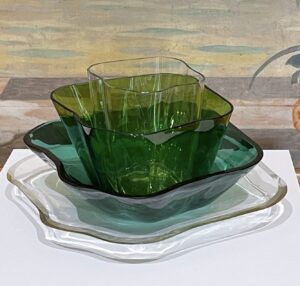
アアルト・フラワー(アルヴァ & アイノ・アアルト)
Aalto’s Flower (Alvar & Aino Aalto)
This was designed jointly by the couple for the Finnish pavilion at the 1939 New York World’s Fair. Alvar Aalto was also responsible for the design of the Finnish Pavilion and exhibition design.
This “Aalto Flower” is displayed above the fireplace in the “Grand Dining Room” of the Tokyo Metropolitan Teien Museum, which was introduced in the previous article <28>, and the painting behind it is by Henri Rapin.

アアルト・フラワー(アルヴァ & アイノ・アアルト)
Aalto’s Flower (Alvar & Aino Aalto)
Rapin’s paintings are also interspersed with flowers, and the background and this “flower” motif are displayed together, and you can feel the intention of the exhibition planner.
Gunnel Nyman
Next is the works of Gunnel Nyman.
She was a furniture designer as well as a lighting designer. She had breast cancer and died at the young age of 39.
At the 1933 Milan Triennale, she won a bronze medal for textiles.
Looking at the works related to the World Exposition, the exhibition this time includes the vessel “Floral Wreath / Garland” designed for the 1937 Paris Universal Exposition, and the work “Wise Virgins“, which was exhibited at the 1937 Paris Universal Exposition and won the gold medal.
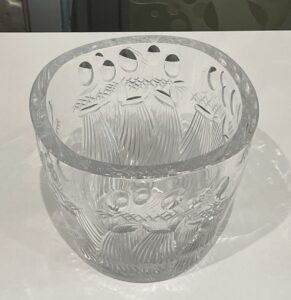
花輪(グンネル・ニューマン)
Floral Wreath / Garland (Gunnel Nyman)
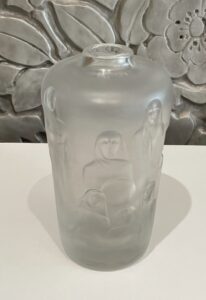
賢明な乙女たち(グンネル・ニューマン)
Wise Virgins (Gunnel Nyman)
In addition, the works “Fish” and “Family” are also exhibited as works exhibited at the 1937 Paris Universal Exposition.
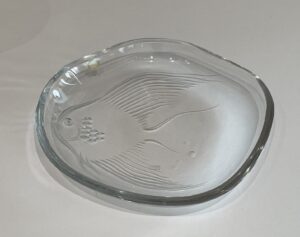
魚(グンネル・ニューマン)
Fish / Garland (Gunnel Nyman)
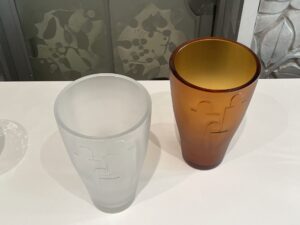
家族(グンネル・ニューマン)
Family (Gunnel Nyman)
Nyman also won a silver medal for furniture and lamps at the 1937 Paris Exposition. She is a very talented person.
And this time, works exhibited at the Milan Triennale are also on display.
The work “Streamer” was exhibited at the Milan Triennale in 1951.
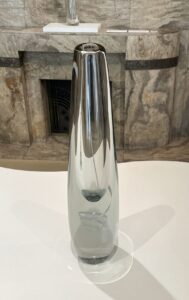
ストリーマー(グンネル・ニューマン)
Streamer / Garland (Gunnel Nyman)
As you can see, it is a very modern and sophisticated work.
Section 2 : The Masters of the Golden Age
The first commentary in Section 2 of the exhibition catalog reads as follows.
*
…there were increasing opportunities for upmarket art glass, which had already attracted considerable interest overseas, to exhibit at the Milan Triennia and other international expositions, to obtain both international recognition and foreign currency. At the 1951, 1954, and 1957 Milan Triennials, in particular, Finnish glass objects gained international renown, securing Finland’s reputation as a nation of design. (Bold is by the author, same below)
*
After all, it can be seen that international exhibitions such as the Milan Triennale played a major role in branding Finland as a design powerhouse.
Kaj Franck
This section first deals with Kaj Franck (1911-1989).
He is widely known as “the conscience of Finnish design“.
Why “conscience”?
The catalog of the “Iittala – Stars of Finnish Glass” held in Bunkamura last year reads as follows.
*
…Franck also focused on the sustainability and lifecycle of products by minimizing the number of daily necessities, driven by a belief in moderation, ecology and equality. Already in 1967, Franck said, “Materials research should shift its focus to the production of reusable materials.” He aimed to minimize the number of household items and consistently demonstrated his great concern for wasting natural resources throughout his work.
*
Kaj Franck also says: (From the catalog)
*
“If you can use the same tableware in many ways, you don’t need to have so many dishes.”
*
That’s a great idea, isn’t it? Even if you only read this part, I think you can understand why Kaj Franck was called “the conscience of Finnish design”.
In the exhibition this time, works such as “Soap Bubble“, a design exhibited at the 1954 Milan Triennale, “Woodcock“, which received an honorary award at the 1954 Milan Triennale, and “Kremlin Bell“, a design exhibited at the 1957 Milan Triennale.
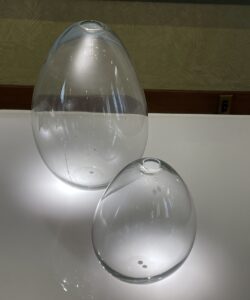
シャボン玉(カイ・フランク)
Soap Bubble (Kaj Franck)
Kaj Franck actually visited Japan once.
In September 1956, Franck spent a month and a half in Japan, during which he met famous Japanese potters such as Hamada Shoji, Kitaoji Rosanjin and Kawai Kanjiro, and visited the Noritake porcelain factory in Nagoya.
Tapio Wirkkala
Next was Tapio Wirkkala (1915-1985).
The exhibition catalog this time says as follows
*
In 1951 and 1954, Tapio Wirkkala was also involved in the exhibition design of the Finnish Pavilion at the Milan Triennale, winning the Grand Prix for both his works and exhibitions, earning international acclaim for his versatility in design.
*
In the exhibition this time, a work called “Elk” is on display. According to the commentary in the catalog, “In Northern Europe, the elk, the largest deer known as the ‘King of the Forest,’ also appears in the Finnish national epic, ‘Kalevala,’ and has been incorporated into many of its motifs.”
As I wrote in <5> Thinking about the World Expo on the news of “Finland joining NATO”②, it is a story that can be said to have become the basis of Finland’s identity.
It is a work with the motif of “elk” that appeared in “Kalevala”.

ヘラジカ(タピオ・ヴィルッカラ)
Elk(Tapio Wirkkala)
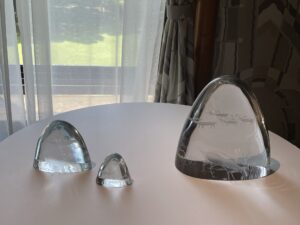
フィヨルド(タピオ・ヴィルッカラ)
Fyeld (Tapio Virkkala)
Another work called “Iceberg” was designed for the 1951 Milan Triennale the year before, and the work called “Tokyo” was exhibited at the 1954 Milan Triennale. By the way, according to the commentary in the catalog, “The title ‘Tokyo’suggests some kind of connection with Japan, but so far the relationship has not been clarified.”
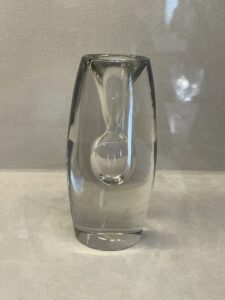
東京(タピオ・ヴィルッカラ)
Tokyo(Tapio Wirkkala)

東京(タピオ・ヴィルッカラ)
Tokyo(Tapio Wirkkala)
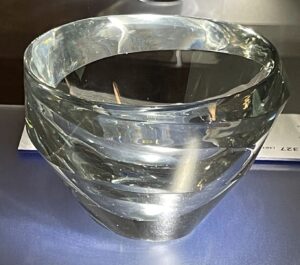
スパイラル(タピオ・ヴィルッカラ)
Spiral (Tapio Virkkala)
But it is a work of interesting design. And modern.
By the way, according to the chronology at the back of the catalog, at the 1954 Milan Triennale, Tapio Wirkkala won the Grand Prix for “Exhibition Design”, “Glass” and “Wood Sculpture”.
Also, at the 1958 Brussels World Exposition, it says, “Tapio Wirkkala designed ‘Future City’”. It can be seen that he was active not only at the Milan Triennale but also at the World Exposition.
Furthermore, in the description of the work “Art-object“, it is stated that “In the wake of the Milan Triennale in 1954, Wirkkalavisited the United States at the invitation of Raymond Loewy, a prominent New York industrial designer, and had the opportunity to belong to Loewy’s design office in 1955-56.”
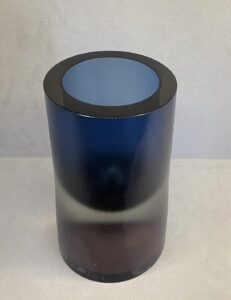
アートグラス(タピオ・ヴィルッカラ)
Art-object(Tapio Wirkkala)
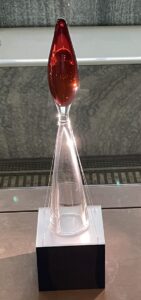
プリマヴェーラ(タピオ・ヴィルッカラ)
Primavera (Tapio Virkkala)
Raymond Loewy (1893-1986) is a person from France who is known in Japan for designing the “Peace” cigarette.
He is a designer who skillfully incorporated the streamlined design of the time and developed bold designs in all genres, from lipsticks to locomotives. For example, he worked on designs that are familiar to us, such as the logo mark of Fujiya, the label of Asahi Beer, the package of Lucky Strike cigarettes, and the logo mark of Shell Oil.
And at the 1939/40 New York World’s Fair, Loewy’s streamlined steam locomotive ran through the venue at 60 miles per hour. At 140 feet long and weighing 526 tons, this locomotive “6100”, was the largest of the Pennsylvania Railroad and was one of the highlights of the outdoor exhibit at the World’s Fair,.
It means that Wirkkala worked in the office of Raymond Loewy, who was active at the New York Expo and gained fame.
Also on display at this exhibition is a work by Wirkkala called “Paadar’s Ice”, which was designed for the 1960 Milan Triennale.
Timo Sarpaneva
Next is Timo Sarpaneva (1926-2006).
The commentary on the catalog reads, “(Timo Sarpaneva) won the Grand Prix for his art glass presented at the Milan Triennale in 1954 and 1957.”
He also designed the “i” mark of Iittala’s logo.
In this exhibition, “Lancet I” exhibited at the 1954 Milan Triennale, “Orchid” also exhibited at the 1954 Milan Triennale, and “Kayak” exhibited at the 1954 and 1957 Milan Triennale. This “Kayak” won the Grand Prix at the 1954 Milan Triennale. It is also used for the cover design of the exhibition catalog this time.
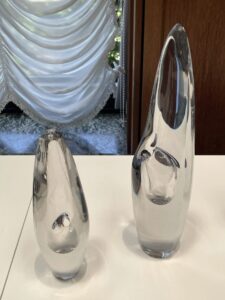
蘭(ティモ・サルパネヴァ)
Orchid (Timo Sarpaneva)

カヤック(ティモ・サルパネヴァ)
Kayak (Timo Sarpaneva)
In addition, the works “Sun Ball” and “Sun in the Forest” were exhibited at the Milan Triennale in 1957 and both won the Grand Prix.
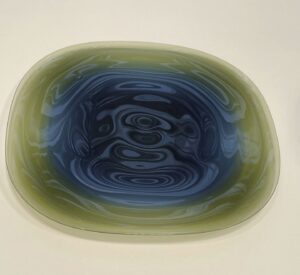
森の太陽(ティモ・サルパネヴァ)
Sun in the Wood (Timo Sarpaneva)
Also, the work “Finlandia / Passion” is on display this time. According to the catalog, “At the 1967 Montreal World Exposition, an installation work, “Pack Ice,” consisting of 585 parts that applied this series was exhibited.”
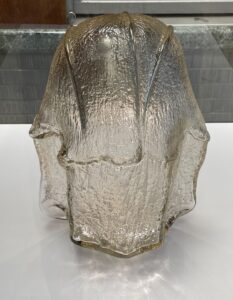
フィンランディア / 情熱(ティモ・サルパネヴァ)
Finlandia / Passion (Timo Sarpaneva)

フィンランディア / 情熱(ティモ・サルパネヴァ)
Finlandia / Passion (Timo Sarpaneva)
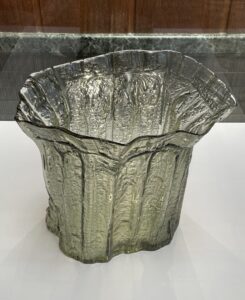
フィンランディア(ティモ・サルパネヴァ)
Finlandia (Timo Sarpaneva)
Timo Sarpaneva also designed the Finnish section of the 1967 Montreal Expo.
Oiva Toikka
And then there is Oiva Toikka (1931-2019).
His work is quite unique.
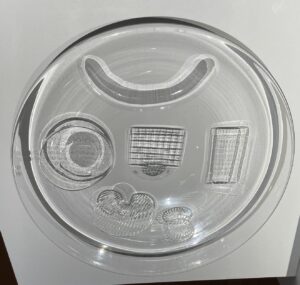
アートグラス、ユニークピース(オイヴァ・トイッカ)
Art-object, unique (Oiva Toikka)
Among them, the work “Pom Pom, unique” is said to have been designed for the Milan Triennale in 1968. According to the catalog, “However, the exhibition was forced to close almost immediately due to student demonstrations against the Italian state authorities, so the following year’s exhibition at the Heal’s department store in London was virtually the first to be shown.”
If you check the BIE website, you can be sure that the 1968 Triennale di Milano was held from June 23rd to July 28th, 1968. It must have been forced to close after a little more than a month.
Section 3 : Finnish Glass Art Today
This section presents works by contemporary artists.
You will be overwhelmed by the many innovative designs.
However, there are many new works in this section, and I could not find any works related to the Expo or the Milan Triennale.
By the way, Iittala is now the only long-established glass factory in Finland that continues to produce glass both in name and reality.
In fact, the history of Iittala was also the history of M&A. Several long-established glass factories that existed in Finland merged or were incorporated under the same owner, and there were twists and turns.
Recently, there was news that Iittala was acquired by Fiskars in 2007.
Fiskars is a company founded in 1649 ( ! ), headquartered in Helsinki, Finland.
In addition to Iittala, Fiskars also includes Wedgwood, Royal Copenhagen, Waterford and so on.
Finland and the Expo
By the way, regarding the Finnish Pavilion at the 1900 Paris Exposition, the first time Finland exhibited at an Expo, I touched on the news of <5> Thinking about the World Expo on the news of “Finland joining NATO”②.
Also, I briefly touched on the 1938 Helsinki World Exposition, which was held in Finland, in <5>, so please refer to it.
In this way, the “Finnish Glass Art – Sparkle and Color in Modern Design” exhibition is full of topics such as the World Expo and the Milan Triennale, and the content was quite busy.
I hope that the reader will understand why I divided this into two parts: <28>Tokyo Metropolitan Teien Art Museum and 1925 Art Deco Expo and this <29>.
This exhibition is a valuable opportunity to rediscover not only an ordinary world exposition, but also one of the four BIE-authorized events, the Triennale di Milano.
In addition, you can also enjoy various Art Deco works from the 1925 Art Deco Expo in the “ Former Residence of Prince Asaka “.
I highly recommend that you visit there.
